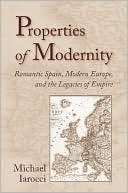

 |

|

The average rating for Properties of Modernity: Romantic Spain, Modern Europe, and the Legacies of Empire based on 2 reviews is 3 stars.
Review # 1 was written on 2012-02-01 00:00:00 Christopher Hellerman Christopher HellermanThis book is incredibly dense and has a thousand references to postmodern theory and philosophy, but it does make the important point that Spain was deemed "unmodern" by northern Europe at the start of the 16th century. This non-modern image followed Spain well into the 20th century and ensured that Spain was marginalized to the point of exclusion from the important modernizing trends of the Enlightenment and romanticism. Spain was written off as barbarously sadistic during the seventeenth century and uncivilized and full of lazy citizens in the eighteenth century before being romanticized as a site for nostalgia for the Middle Ages in the nineteenth century. All the while Spaniards were in fact participating in the important cultural productions of literature, art, and music that everyone else in northern Europe was enjoying. The result of Spain's repeatedly being told by northern Europe (mostly France, England, and Germany) "you are not modern" is that Spain's literature has hardly been recognized outside Spain and Hispanist scholarship. It's quite acceptable to study comparative literature and be an expert on romanticism without ever having read a word of the great Spanish romantics José Mariano de Larra, Gertrudis Gómez de Avellaneda (who in fact wrote the first abolitionist novel in the Western hemisphere, but so many people ignore this), or José Cadalso or be an "expert" on the nineteenth-century European novel and never have heard of the great Spanish novelists Benito Pérez Galdós and Emilia Pardo Bazán. Iarocci does a great job of tracing why Spanish literature has been written off by the European canon, and what we present-day scholars can do by studying Spanish literature's incorporation and reactions to European literary trends instead of dismissing it as inferior or vastly different than the literature of France, England, and Germany. |
Review # 2 was written on 2011-05-06 00:00:00 Daniel Meyers Daniel MeyersThis is one of my most precious memories of my childhood. Before going to school, sometimes after, I used to go to a nearby kiosk and buy some chocolates. But these chocolates weren't ordinary ones. They came wrapped with tiny books inside: the fables of Jean de La Fontaine. That is one of my earliest independent, adult-free contacts with literature that I can remember, so I really treasure those fables. I didn't know they were such classics of the 17th century. I found them entertaining so I started collecting them (I've never liked chocolate that much, so I used to give it to other kids) and eventually, they led me to Aesop. Thanks to my grandma, actually, my GR back then. Around that time, she started flooding my house with books and was the one who encouraged me to start taking English lessons with her. "The Lion and the Mouse", "The Ant and the Grasshopper", "The Cat and the Mice", "The Mice in Council", "The Fox and the Grapes", "The Fox and the Stork"... all favorites of mine. Damn, now I am truly nostalgic. Well. I hope you enjoy my "it has nothing to do with the book" review. I gave this book 4 stars at first, but now I'm a mixture of books, images and nostalgia so, a 5-star rating it is. Sep 14, 13 * Also on my blog. |
CAN'T FIND WHAT YOU'RE LOOKING FOR? CLICK HERE!!!